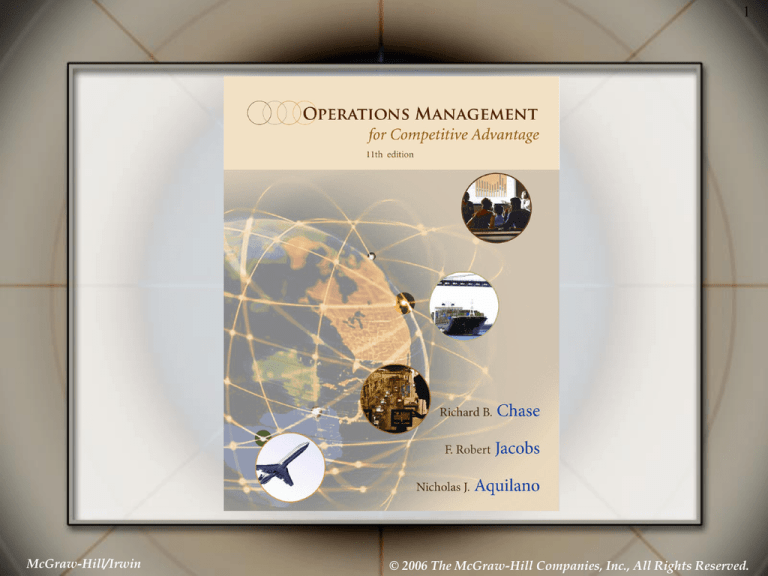
1
McGraw-Hill/Irwin
© 2006 The McGraw-Hill Companies, Inc., All Rights Reserved.
2
Chapter 10
Supply Chain Strategy
©The McGraw-Hill Companies, Inc., 2006
3
OBJECTIVES
Supply-Chain Management
Measuring Supply-Chain
Performance
Bullwhip Effect
Outsourcing
Value Density
Mass Customization
McGraw-Hill/Irwin
© 2006 The McGraw-Hill Companies, Inc., All Rights Reserved.
4
What is a Supply Chain?
Supply-chain is a term that describes
how organizations (suppliers,
manufacturers, distributors, and
customers) are linked together
Services
Supply networks
Manufacturing
McGraw-Hill/Irwin
Suppliers
Service support
operations
Local
service
providers
Customers
Inputs
Transformation
Localization
Output
Suppliers
Manufacturing
Distribution
Customers
© 2006 The McGraw-Hill Companies, Inc., All Rights Reserved.
What is Supply Chain
Management?
5
Supply-chain management is a
total system approach to
managing the entire flow of
information, materials, and
services from raw-material
suppliers through factories and
warehouses to the end customer
McGraw-Hill/Irwin
© 2006 The McGraw-Hill Companies, Inc., All Rights Reserved.
6
Formulas for Measuring SupplyChain Performance
One of the most commonly used measures in
all of operations management is “Inventory
Turnover”
Cost of goods sold
Inventory turnover
Average aggregate inventory value
In situations where distribution inventory is
dominant, “Weeks of Supply” is preferred and
measures how many weeks’ worth of inventory
is in the system at a particular time
Average aggregate inventory value
52 weeks
Weeks of supply
Cost of goods sold
McGraw-Hill/Irwin
© 2006 The McGraw-Hill Companies, Inc., All Rights Reserved.
7
Example of Measuring SupplyChain Performance
Suppose a company’s new annual report
claims their costs of goods sold for the
year is $160 million and their total average
inventory (production materials + work-inprocess) is worth $35 million. This
company normally has an inventory turn
ratio of 10. What is this year’s Inventory
Turnover ratio? What does it mean?
McGraw-Hill/Irwin
© 2006 The McGraw-Hill Companies, Inc., All Rights Reserved.
Example of Measuring SupplyChain Performance (Continued)
8
Cost of goods sold
Inventory turnover
Average aggregate inventory value
= $160/$35
= 4.57
Since the company’s normal inventory turnover ration
is 10, a drop to 4.57 means that the inventory is not
turning over as quickly as it had in the past. Without
knowing the industry average of turns for this
company it is not possible to comment on how they
are competitively doing in the industry, but they now
have more inventory relative to their cost of goods
sold than before.
McGraw-Hill/Irwin
© 2006 The McGraw-Hill Companies, Inc., All Rights Reserved.
9
Bullwhip Effect
The magnification of variability in orders in the supplychain
Retailer’s Orders
Wholesaler’s Orders
Time
A lot of
retailers each
with little
variability in
their orders….
McGraw-Hill/Irwin
Time
…can lead to
greater variability
for a fewer number
of wholesalers,
and…
Manufacturer’s Orders
Time
…can lead to
even greater
variability for a
single
manufacturer.
© 2006 The McGraw-Hill Companies, Inc., All Rights Reserved.
Hau Lee’s Concepts of Supply
Chain Management
10
Hau Lee’s approach to supply chain (SC) is one of
aligning SC’s with the uncertainties revolving around the
supply process side of the SC
A stable supply process has mature technologies and an
evolving supply process has rapidly changing
technologies
Types of SC’s
– Efficient SC’s
– Risk-Hedging SC’s
– Responsive SC’s
– Agile SC’s
McGraw-Hill/Irwin
© 2006 The McGraw-Hill Companies, Inc., All Rights Reserved.
Hau Lee’s SC Uncertainty
Framework
11
Demand Uncertainty
Supply
Uncertainty
McGraw-Hill/Irwin
Low
(Stable
Process)
High
(Evolving
Process)
Low (Functional
products)
High (Innovative
products)
Efficient SC
Responsive SC
Ex.: Grocery
Ex.: Computers
Risk-Hedging SC
Agile SC
Ex.: Hydroelectric power
Ex.: Telecom
© 2006 The McGraw-Hill Companies, Inc., All Rights Reserved.
12
What is Outsourcing?
Outsourcing is defined as the act of
moving a firm’s internal activities
and decision responsibility to
outside providers
McGraw-Hill/Irwin
© 2006 The McGraw-Hill Companies, Inc., All Rights Reserved.
13
Reasons to Outsource
Organizationally-driven
Improvement-driven
Financially-driven
Revenue-driven
Cost-driven
Employee-driven
McGraw-Hill/Irwin
© 2006 The McGraw-Hill Companies, Inc., All Rights Reserved.
14
Value Density
Value density is defined as the
value of an item per pound of
weight
It is used as an important measure
when deciding where items
should be stocked geographically
and how they should be shipped
McGraw-Hill/Irwin
© 2006 The McGraw-Hill Companies, Inc., All Rights Reserved.
15
Mass Customization
Mass customization is a term used to
describe the ability of a company to
deliver highly customized products and
services to different customers
The key to mass customization is
effectively postponing the tasks of
differentiating a product for a specific
customer until the latest possible point
in the supply-chain network
McGraw-Hill/Irwin
© 2006 The McGraw-Hill Companies, Inc., All Rights Reserved.
16
End of Chapter 10
McGraw-Hill/Irwin
© 2006 The McGraw-Hill Companies, Inc., All Rights Reserved.





